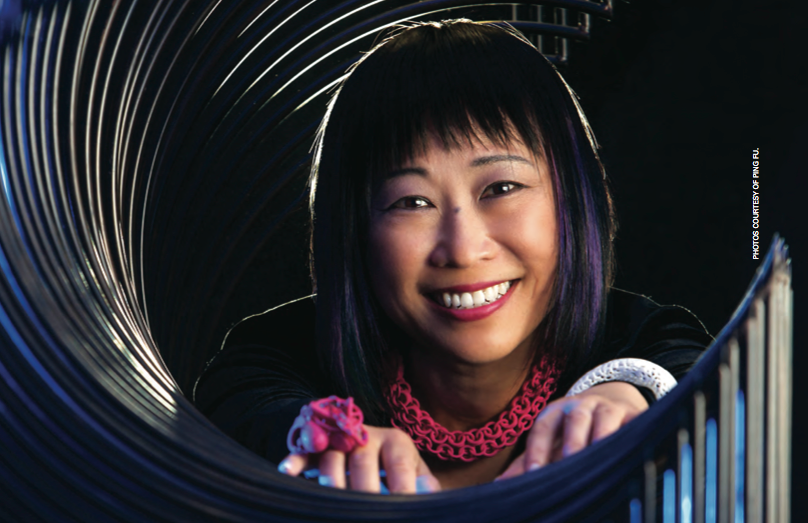Story by Ada Tseng.
While speaking about her new memoir, Bend, Not Break: A Life in Two Worlds, a story that follows the author’s disgrace as a “black element” during China’s Cultural Revolution to her rise as a successful tech CEO in the U.S., entrepreneur Ping Fu often wore a pair of eye-catching, hot pink platform heels to interviews and publicity events. The shoes, made by 3D printers and designed by Janne Kyttanen, creative director of 3D Systems, were lightweight, machine-washable and customized to fit Fu’s feet perfectly. One of the pairs even had a special pocket on the side to hold an iPhone.
“Shoes are the ultimate science-meets-art object,” says Fu, a pioneer of 3D imaging software technology. “We all like shoes to be beautiful, but they are also, scientifically, very difficult to make. They have to have the perfect balance, shape and form for how each individual walks, things that are very difficult for a computer to interpret. But because everyone can relate to them, they show that life and technology are not two different things. Technology must transcend humanity to touch people’s lives.”
In addition to shoes, Fu often wears 3D-printed jewelry and carries 3D-printed bags, not only because she embraces being a female executive in technology, known for being a young man’s world, but also because the 50- something believes that you have to live and experience what you create in order to know how to take your creation even further.
While 3D printing has been around for decades – Fu started her company Geomagic in 1997 after seeing a 3D printer print a solid object for the first time – it’s only been in the last couple of years that the industry has exploded into the mainstream.
“This is the most exciting time for advanced manufacturing,” says Fu. “Not a day goes by where there isn’t news of another major company using 3D printing to enhance its business model.”
This is not the first time Fu has been at the forefront of technological innovation. While working at the National Center for Supercomputing Applications in the ’90s, she was part of the initial team working on the software project NCSA Mosaic that ended up becoming Netscape, the first widely used Web browser that made a tech star out of Fu’s colleague, Marc Andreessen. When Fu decided to build her own company, she opted out of starting a then-trendy dot-com, instead searching for a project that would utilize her background in visual computing.
[wp_ad_camp_1]
“I was really hooked by the 3D printers,” says Fu, who believes her interest in manufacturing goes way back to her pre-teen and teen days building radios and making car parts in Chinese factories. “I did some research and realized there were a lot of 3D scanners and 3D printers, but what was missing at the time was some sort of 3D software that fit in between. That was the beginning of what I thought Geomagic should be.”
At one of her first investor conferences, Fu asked the crowd to imagine your kid printing out his first sculpture; an orthopedic surgeon printing a 3D model of your prosthetic knee a week before your surgery; walking into a shoe store, getting your foot scanned and returning the next day for your custom- fitted boots. Soon enough, others had visions for how this type of technology could help their own industries.
“All of these were just ideas, and I said that Geomagic would turn these ideas into reality,” Fu remembers. She laughs. “Frankly, at that point, I did not know that it could happen. Little did I know how long it would take to turn the very difficult technology into reality.”
Now Fu believes that 3D printing is even bigger than the Internet. While the Internet changed how we display and share data, 3D printing would allow us to use data to make tangible objects. With the trifecta of 3D scanners, software and printers becoming more and more accessible, mass production (which has long been outsourced to factories abroad) will be replaced with mass customization (which will be distributed locally, near customers).
[wp_ad_camp_2]
“In the next few years, I believe that we will fundamentally disrupt how things are designed and manufactured, and this will have an impact on everybody’s lives,” says Fu. “Products will be more customized, service more personable, manufacturing will be distributed and products made locally, and it’ll be more green because we’ll make less of what we don’t want and we’ll ship fewer things overseas.”
In fact, in 2010, she was appointed to the National Advisory Council on Innovation and Entrepreneurship run by the U.S. Department of Commerce, and one of her current goals is to focus on how 3D printing can help create more jobs domestically, while simultaneously opening up a more genuine cultural exchange internationally.
Back in 2005, when Fu was named Entrepreneur of the Year by Inc. Magazine, some advised her to take advantage of her initial hype and sell Geomagic to the highest bidder. Instead, Fu elected to take her company to the next level, and it wasn’t until February 2013 that she sold Geomagic to 3D Systems, founded by Chuck Hull, the inventor of the first 3D printing machine. It was a homecoming for Fu, as it was Hull’s presentation that had inspired Fu to start Geomagic in the first place.
Now the chief strategy officer and vice president of 3D Systems, Fu continues to “write software for the future not yet imagined,” as she first fantasized when she decided to study computer science as a new immigrant in America. Fast forward to the present: “Today Invisalign, an orthodontic treatment without wires and brackets, is printing 65,000 custom aligns per day,” she says. “Soon enough, we’ll be ordering our own customized shoes.
“It’s going to come quickly, like a fresh wave washing up the shore,” says Fu. “And I just think it’s really exciting.”
WHO INFLUENCES PING FU? When asked who influences her, Ping Fu rattles off a long list of names, from Mahatma Gandhi to Nelson Mandela, Sir Harold Evans to Michelle Obama. But it’s Chuck Hull who she calls the greatest mentor of all time. “Thirty years ago, he printed the first 3D printed part,” says Fu. “To put it into perspective, at that time, Macintosh had not been released, and there was no direct connectivity of 3D modeling software to 3D printers, so the fact that he could even print a part was a miracle. And he’s still in the company! Talk about resilience and tenacity. Chuck is the hero. Without him, we would not have this technology today.”
This story was originally published in our Winter 2013-14 issue. Get your copy here.










